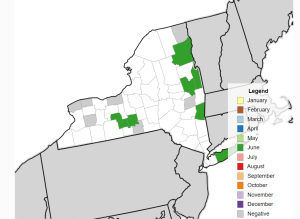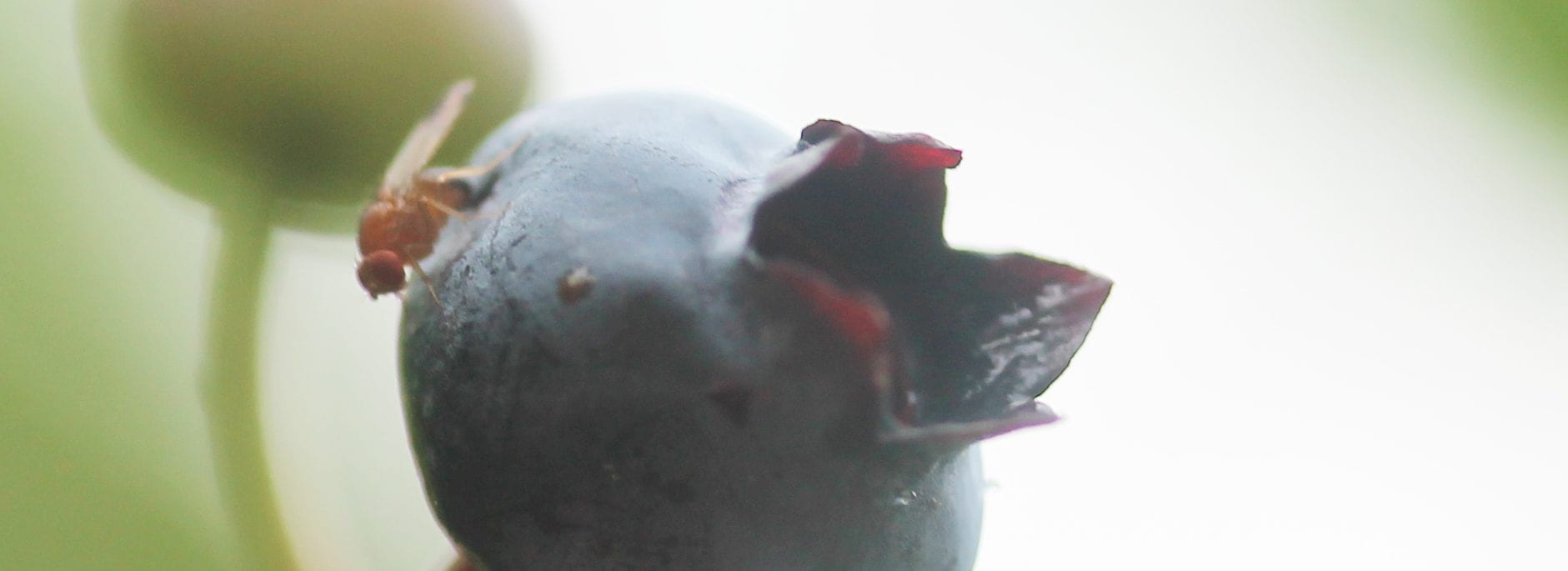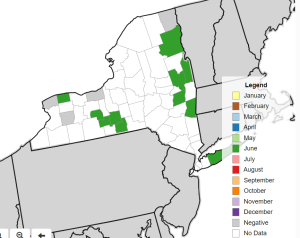A single female swd was trapped in a drowning jar trap in Wayne county yesterday. The trap was placed in a ripening tart cherry orchard.
Sustained trap catch in Columbia and Washington counties
We have reached sustained trap catch in Columbia County in ripe cherries yesterday, with 6 male SWD found on sticky cards and 7 females and 14 males in drowning jar traps.
We also reached sustained trap catch in Washington County in blueberries yesterday, with a single male SWD found on a sticky card
First trap catch in Orleans county
Sustained trap catch in Tompkins and Schuyler counties
We've reached sustained catch in Tompkins and Schuyler county:
In Tompkins county, 1 female was found in a drowning trap in raspberries.
In Schuyler county, 1 female was found in drowning trap in blueberries.
First trap catch in Albany and Tioga counties
First catch was reached today in Albany County, with 7 males on sticky traps and 5 females and 5 males on drowning jar traps. All traps were in raspberries with ripe fruit. Thank you to Natasha Field for checking those traps!
We also reached first trap catch in Tioga county, 2 males and 3 females found in drowning traps in blueberries. Thank you to Anya Osatuke for checking that trap!
Here are some management recommendations (Copied from https://fruit.cornell.edu/spottedwing/management/)
- Excellent sanitation to reduce SWD populations.Fruit should be harvested frequently and completely to prevent the buildup of ripe and over-ripe fruit. Unmarketable fruit should be removed from the field and either frozen, “baked” in clear plastic bags placed in the sun, or disposed of in bags off-site. This will kill larvae, remove them from your crop, and prevent them from emerging as adults.
- Canopy and water management to make the environment less favorable.Prune to maintain an open canopy, increase sunlight and reduce humidity. This will make plantings less attractive to SWD and will improve spray coverage. Repair leaking drip lines and avoid overhead irrigation when possible. Allow the ground and mulch surface to dry before irrigating. Female flies prefer to lay eggs in shaded locations, away from heat and sunlight.
- Exclusion netting to prevent SWD infestation of fruit. Insect exclusion netting can be installed prior to the arrival of SWD to create a physical barrier between the insects and the fruit. Netting is woven polyethylene yarn, available in different gauges (i.e. hole size). Field trials have demonstrated that 80 gram netting (1.0 x 0.6 mm) is effective for exclusion, but 60 gram netting is not. Netting is 100% effective if effectively managed, meaning netting is installed before SWD arrives, no holes are present, and nets are routinely inspected and maintained throughout the season. Netting also provides protection from other damage, such as birds, high wind, and hail. For more detailed information, see Thinking exclusion? on the NYSIPM Spotted Wind Drosophila blog.
- Insecticide sprays will kill SWD adults and thereby reduce egg laying:Insecticide treatments should begin when fruit are ripe or ripening and SWD are found in traps. Follow regional monitoring alerts about the first SWD trap catch nearest your farm or consider monitoring SWD traps in your susceptible fruit crops. Keep records of when susceptible fruit crops begin to ripen. Treatments should be applied at least every seven days and repeated in the event of rain. Choose the effective insecticides with pre harvest intervals that work for your picking schedule. Rotate insecticides according to their modes of action. Use the most effective insecticide when you first initiate your spray program — research shows this delays the build up of SWD over time.
Quick reference guides:
- SWD insecticides for berries
- SWD insecticides for stone fruits and grapes
- SWD insecticides for treating dropped fruit
Check the Cornell Guidelines for the latest list of approved pesticides in NYS. Special needs labels and 2(ee) recommendation labels are being sought for NY berries and cherries. Always read and follow the pesticide label instructions and have the special needs or 2(ee) labels with you when applying.
- Regular fruit sampling:At least 100 fruit per block per harvest should be observed for infestation. Talk to your local CCE agent about a monitoring program. Fruit can be inspected for evidence of larval feeding. Small holes in berries where the eggs were laid may leak juice when the berry is gently squeezed; this is especially diagnostic on blueberry. Infested red raspberry fruit may leave a red juice stain on the berry receptacle when the fruit is picked. Fruit with small indents or bruises where the surface appears to have flattened or deflated may be infested — typical of SWD infestation in blueberry, strawberry, and cherry. A salt flotation method, immersing fruit in a solution of 1 Tbsp. (14.8 cc) table salt per 1 cup (236.6 ml) water, may cause larvae to emerge from fruit and die so they can be easily quantified. At least 100 fruit per block per harvest should be observed for infestation. Suggested methods were adapted for NY growers in Guidelines for Checking Fruit for SWD Larvae in the Field (pdf).
- Cool berries immediately:Chilling berries immediately after harvest to 32o – 33o F will slow or stop the development of larvae and eggs in the fruit. U-Pick customers should be encouraged to follow this strategy to improve fruit quality at home.
First trap catch in Essex, Washington and Saratoga counties
In each of Essex, Washington and Saratoga counties, we reached first trap catch for spotted wing drosophila. At each location, a single male swd was found on a sticky card trap. Thank you to Laura McDermott and Natasha Field for monitoring those traps!
We are on schedule with first trap catches from last year.

First trap catch in Columbia county
Spotted wing first trap catch is showing up across many parts of the state this week. At highest numbers caught yet this year, we found first catch this morning in Columbia county in ripe sweet and sour cherries.
2 males were found on red sticky traps, and 4 males and 3 females were found in jar drowning traps.
First swd trap catch in Schuyler and Tompkins counties
First swd caught in Rensselaer county
One male was captured in a drowning jar trap in Rensselaer County on Sunday 6/19 in an Amelanchier (serviceberry) hedgerow. Thanks to Dale-Ila Riggs at the Berry Patch for monitoring at her farm and providing this information.
We expect SWD to be prevalent throughout most of the Capital Region soon, particularly after the ample rainfall we received last week. We will continue to provide updates as it is identified in other locations.
One of the management tactics Dale-Ila is deploying includes exclusion netting. She has been using netting and collaborating with CCE research on this practice for a number of years, with outstanding results. This type of management can provide 100% control if properly executed. Dale-Ila is currently in the process of putting up nets and hopes to have them in place by the end of the week.
Insect exclusion netting can be installed prior to the arrival of SWD to create a physical barrier between the insects and the fruit. Netting is woven polyethylene yarn, available in different gauges (i.e. hole size). Field trials have demonstrated that 80 gram netting (1.0 x 0.6 mm) is effective for exclusion, but 60 gram netting is not. Netting is 100% effective if effectively managed, meaning netting is installed before SWD arrives, no holes are present, and nets are routinely inspected and maintained throughout the season. Netting also provides protection from other damage, such as birds, high wind, and hail. For more detailed information, see Thinking exclusion? on the NYSIPM Spotted Wind Drosophila blog.
First SWD caught in New York this summer
The first spotted wing drosophila of the season was trapped yesterday.
1 female was caught in a drowning jar trap in a blueberry planting in Penn Yan (Yates county). Thank you to Anya Osatuke for checking that trap!
Fruits of susceptible crops can be attacked as soon as they begin to blush or soften. Susceptible crops include raspberries, blackberries, cherries, blueberries, peaches, and thin-skinned grapes.
Spotted wing can be managed using a combination of cultural and chemical practices. You will need to be diligent.
- Excellent sanitation will reduce SWD populations. Fruit should be harvested frequently and completely to prevent the buildup of ripe and over-ripe fruit. Unmarketable fruit should be removed from the field and either frozen, “baked” in clear plastic bags placed in the sun, or disposed of in bags off-site. This will kill larvae, remove them from your crop, and prevent them from emerging as adults.
- Cool berries immediately. Chilling berries immediately after harvest to 32° – 34° F will slow or stop the development of larvae and eggs in the fruit. U-Pick customers should be encouraged to refrigerate fruit immediately to maintain fruit quality at home.
- An open canopy and dripline irrigation will make the environment less favorable. Prune to maintain an open canopy, increase sunlight and reduce humidity. This will make plantings less attractive to SWD and will improve spray coverage. Repair leaking drip lines and avoid overhead irrigation when possible. Allow the ground and mulch surface to dry before irrigating.
- Insecticide sprays will kill SWD adults and thereby reduce egg laying. Insecticide treatments should begin at first SWD trap catch when highly susceptible fruit crops, such as raspberries and blackberries, begin ripening.
Insecticides should be re-applied at least every seven days and more often in the event of rain. Choose the most effective insecticides with pre-harvest intervals that work for your picking schedule. Rotate insecticides according to their modes of action. Quick reference guides can be found for berries or stone fruits.


